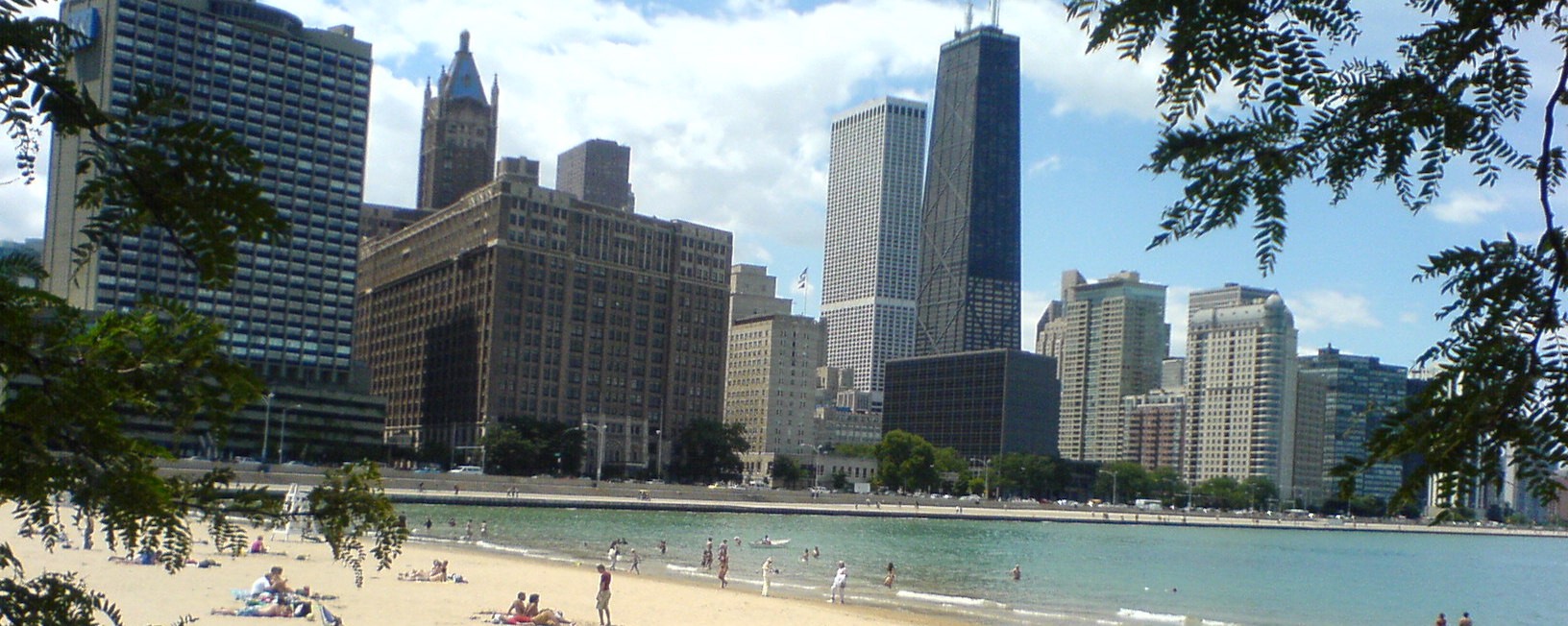

Chicago is a city of distinct neighborhoods, each with its own unique story and flavor. Rogers Park, where I live, was recently named the top neighborhood in Chicago by real estate site Trulia. To rank the larger city neighborhoods, Trulia used measures of livability–including play places for children, quiet streets, and amenities such as hospitals, pharmacies, and day care facilities. Rogers Park came in at #11 nationally, and #1 in Chicago.
Since I landed in this neighborhood almost a year ago, I’ve marveled at the amount of green space it contains. Stretching from the seemingly unending shores of Lake Michigan into the Far North Side of Chicago, the area has parks, trees, and greenery unlike the skyscrapers of downtown or the bustling concrete of other parts of the city. Living here means feeling better as a result of a little more blue and green space in the urban landscape of Chicago–dubbed urbs in horto, or “city in a garden.”
But does it really? Can nature-infused spaces actually help people feel better in the midst of the city hustle? How important is green space to the mental health of people who live in a city?

Cities can often be hard places to inhabit. They’re loud, busy, and crowded, and those elements can make them overwhelming and stressful.
There’s also a clear link between city living and mental illness. Recent scientific studies further confirmed what we have known for quite a while now–living in a city is a risk factor for mental disorders. A 2010 meta-analysis of 20 separate population studies found that city living sharply increased the chance of having mental issues such as anxiety, depression, or other mood disorders.
Another study from 2011 found that the brains of people who live in urban environments react to stress with more activity in the amygdala, a brain region that is related to fear and emotion. Researchers also saw an “urban” effect on the brains of people who grew up in cities–their brains had differences in a region of the cortex that affects the amygdala and is linked to regulating negative emotions and stress.
But what are the reasons behind these differences in the brains of city and country folk? They may be due to the phenomenon of increased “social stress” in the daily lives of city dwellers. Living in a city means more social stress–or coming into contact with tons more people on a daily basis than when living in a more rural area. It also means having less control over an increased amount of interaction with strangers. In the 2011 study, researchers employed a type of social stress–disapproving feedback when performing a task–that revealed differences in the emotional parts of the brains of city and rural dwellers. Perhaps the increased incidences of social stressors in the city–little daily hassles like pushing through crowded city corners or being a victim of street harassment–all add up to making someone more prone to mood disorders.
Meanwhile, the percentage of the world’s population living in urban areas is growing. Currently, over half of the world’s population lives in cities, and that number is expected to grow to over 66 percent of humans everywhere by the year 2050. What can we do to ensure that we all stay healthy in the fray?

When my husband and I moved to Chicago, we secured an apartment with a wooden Chicago-style deck. I immediately started making regular investments at the local garden center to decorate the interior and exterior of our home with plants of all types. I’ve found that plants really do furnish a space, making it inviting and calming, as well as cleaning indoor air. I loved creating a green space of foliage in our home, and the fact that we’re just a short walk from the beaches of Lake Michigan provided a nearby blue space to enjoy as well.
It turns out that a number of scientific studies bear out my inkling that blue and green spaces can be beneficial to physical and mental health.
Studies have shown that having plants in a hospital environment can actually help patients achieve better health outcomes. Even the simple act of looking at pictures of greenery can help speed up recovery from stress.
In June 2015, a study from Stanford University found that taking walks in nature aided people’s emotional health. When participants took a 90-minute-long walk in a natural setting versus in a city setting, compared to the city walk, the nature stroll decreased participants’ reports of rumination–a type of repeated brooding over negative thoughts or events that is linked to an increased risk of developing depression.
When scanning the participants’ brains, the researchers also found that the nature walk decreased activity in the subgenual prefrontal cortex (sgPFC), a brain region active during rumination.
Meanwhile, we’ve seen an increased interest in research in shinrin-yoku, the Japanese term for “forest bathing” or spending time taking in a natural environment. Researchers have documented improved mood and improved physical measures of stress after a forest bath, leading them to call for further investigations into this effect.

It seems there is a link between nature-infused settings, stress reduction, and mental health. But does this link have potential real-world applicability?
Perhaps, yes. In 2014, researchers from the University of Exeter Medical School found that people who moved from a less-green urban area to a more green urban area found long-lasting improvements in their mental health. The subjects, whose data was taken from the British Household Panel Survey, were followed for five years–two years before their move, and three years after.
Another study, out this year from researchers in New Zealand, investigated the relationship between blue spaces, like rivers, lakes, and other bodies of water, and mental health. They found that residents of Wellington, New Zealand, had lower scores of psychological distress when they lived within view of water.
That said, while it’s exciting to see support for a link between green and blue spaces and improved mental health, I’d like to temper this excitement with a bit of caution. Although we are seeing some links between natural settings and improvement in mental health, most of the studies I’ve mentioned linking natural spaces in the city and mental health are correlational–in other words, they’ve looked at pre-existing data to see trends, rather than experimenting directly to see if the green and blue spaces themselves cause the improvements.
Another caveat is that neighborhoods or urban areas with more green spaces may have other qualities that improve mental health that are unrelated to nature. That is to say, they may just be overall more pleasant places to live for other reasons; higher-income areas tend to have more green and blue spaces. In fact, The Washington Post recently reported that high-income neighborhoods have a higher average tree cover rating–81 percent–than lower income neighborhoods’ 48 percent tree cover rating.
Regardless, the link between well-being and nature seems robust, and many people can attest to the benefits of time spent in nature to refresh and renew the mind. As we grow and change our cities, we should make building natural spaces a priority. A few major cities have made starts–repurposing older spaces into green ones. In New York City, the High Line is a green space created out of an old, unused railway, and plans are in the works to create the Lowline, a potential underground park in the old Williamsburg Bridge Trolley Terminal, which would be the world’s first green space that redirects sunlight underground.
Even simpler actions like making room for community gardens or urban landscaping can achieve the same goals of greening a city space. Keeping the mental health benefits of green and blue spaces in mind can help as the world’s population moves into a more urban and, hopefully, more natural space.
My indoor plant colony is going strong, and I will be adding more to its numbers as time goes on. Now that it’s springtime and the weather is warming up, I’m itching to place the seedlings I planted in the dead of winter out on my little wooden deck. I’m thrilled, too, by the calm promise of warm walks through the green and blue of my neighborhood–from the lake, to the gardens, to the trees in bloom.


How We Get To Next was a magazine that explored the future of science, technology, and culture from 2014 to 2019. This article is part of our Metropolis section, on the way cities influence new ideas–and how new ideas change city life. Click the logo to read more.
